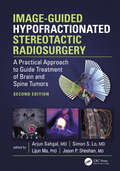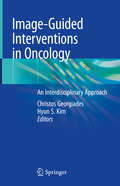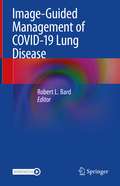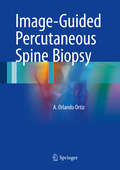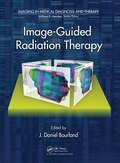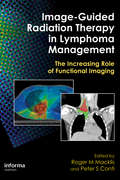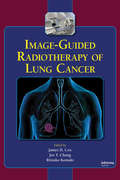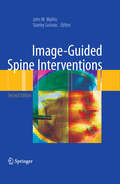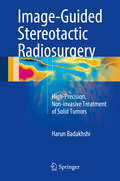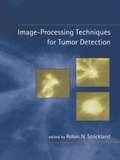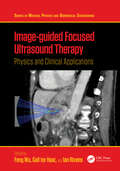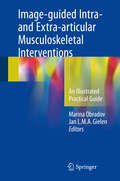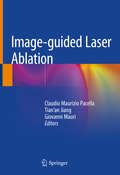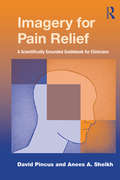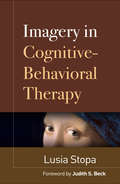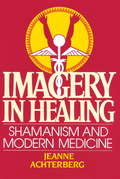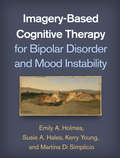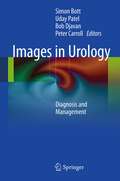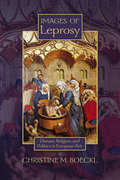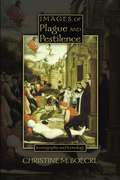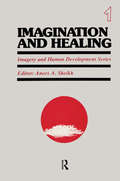- Table View
- List View
Image-Guided Hypofractionated Stereotactic Radiosurgery: A Practical Approach to Guide Treatment of Brain and Spine Tumors
by Arjun SahgalFollowing recent developments in hypofractionated stereotactic radiation therapy (SRT) for brain and spine tumors, this new edition offers a fully updated and comprehensive "how-to" guidance on hypofractionated SRT for brain and spine metastases, glioma, benign tumors, and other tumor types. Presenting the state of the art of the technology and practice, this book: • Discusses the pros and cons of hypofractionated SRT compared to single-fraction radiosurgery, providing a deeper understanding of radiosurgery and radiobiology • Explains the toxicity and adverse effects of hypofractionated SRT including the dosage of 24 Gy in two spine SBRT fractionation schemes, aiding practitioners in communicating the risks and benefits of treatment and in obtaining consent from their patients• Outlines the current standards for safe practice, including checklists for implementation• Explores new technologies for brain and spine tumors including LITT, MR-guided focused ultrasound, and Zap technology, with chapters authored by well-recognized experts in the radiation, oncology, and neurosurgery communities; this book delivers a level of technological and clinical detail not available in journal papers This book is suitable for radiation oncologists, neurosurgeons, and medical physicists who specialize in brain and/or spine radiosurgery or want to start a program and need a comprehensive reference with key checklists for practice.
Image-Guided Interventions in Oncology: An Interdisciplinary Approach
by Christos Georgiades Hyun S. KimThis book provides an up-to-date and comprehensive primer on image-guided interventions for cancer. Image-guided interventional oncology is gaining popularity as it is a minimally invasive and more precisely targeted approach that both proves more effective and results in fewer side effects. This book’s aim is to provide a clinical guide to interventional oncology for the entire oncology team. Chapters are approached with the same interdisciplinary perspective that is used in the care itself, with each chapter written by an interventional radiologist with contributions from medical, surgical and/or radiation oncologists. Chapters cover the major cancers that can benefit from interventional oncology treatment (including lung, liver, kidney, and bone), as well as some of the physics and physiology behind these interventional modalities. This is an ideal guide for interventional radiologists, medical oncologists, surgical oncologists, radiation oncologists, as well as relevant trainees.
Image-Guided Management of COVID-19 Lung Disease
by Robert L. BardThis book offers a detailed and up-to-date overview of image-guided diagnostics in COVID-19 lung disease. A range of image-guided CT and ultrasound procedures in different chest regions are described. For each procedure, the benefits of image guidance are presented and its specialized application explained in the adult (outpatient, triage and hospital setting) and the pediatric patient. Lung Ultrasound Image Guidance assesses this rapidly evolving disease in real time while CT scans may be precisely targeted. The editor provides his 50+ year experience of multidisciplinary chest imaging including battlefield experience to optimally combat this recent viral assault. Image-Guided Management will be a valuable guide and reference not only for radiologists and pulmonary practitioners, but also for imaging technicians and First Responders. The intense public interest in safety and prevention is covered in the chapters on protection and decontamination. A chapter addressing the multiplicity of organ damage is useful for cardiologists and internists given the long differential diagnosis of respiratory distress entities. The emergence of point of care ultrasound providing 24/7 diagnostic access into inflammatory processes of the lung heralds its ascendance to the top tier of acute care diagnostic tools.
Image-Guided Percutaneous Spine Biopsy
by A. Orlando OrtizThis textbook covers key areas and reviews important principles and steps in the preparation for and the performance of spine biopsy. Image-guided percutaneous biopsy techniques and their application throughout the spinal axis are presented and discussed in detail. The advantages and disadvantages of various spine biopsy instruments are reviewed. Commonly encountered biopsy scenarios are considered in order to help readers effectively manage these situations when they occur in their practices. Clear guidance is offered on patient selection and preparation, which are critical to safe and effective outcomes, and much emphasis is placed on procedural safety, with a focus on complication avoidance and the appropriate reporting of complications. Image-Guided Percutaneous Spine Biopsy will be a welcome one-stop shop providing up-to-date information for all physicians with an interest in the subject, including radiologists, surgeons, and pathologists.
Image-Guided Radiation Therapy (Imaging in Medical Diagnosis and Therapy)
by J. Daniel BourlandImage-Guided Radiation Therapy presents key image-guided radiation treatment (IGRT) technologies for external beam radiotherapy. The book explores the decades-long technological developments that have occurred in the realm of image-guided conformal, customized radiation treatment. Expert authors, all of whom have actively participated in the develo
Image-Guided Radiation Therapy in Lymphoma Management: The Increasing Role of Functional Imaging
by Roger M Macklis Peter S ContiAn ideal text for radiation oncologists, hematologist-oncologists, and radiologists, Image-Guided Radiotherapy and Functional Imaging in Modern Lymphoma Management is the foremost source for information on the increasingly important subject of image guided radiation therapy (IGRT) and its crucial role in the clinical evolution of high-precision ion
Image-Guided Radiation Therapy of Prostate Cancer
by David A. Jaffray Richard K. Valicenti Adam P. DickerAnswering the need that exists for a single reference to address the practical issues of implementing Image-guided Radiation Therapy (IGRT) into prostate cancer treatment, Image-guided Radiation Therapy of Prostate Cancer provides clinicians with a solid understanding of this technology and, through in-depth illustrations and step-by-step guideline
Image-Guided Radiotherapy of Lung Cancer
by Ramjee PrasadLung cancer is the leading cause of cancer death in the United States, but IGRT (image guided radiation therapy) offers the possibility of more aggressive and enhanced treatments. The only available source on the subject that emphasizes new imaging techniques, and provides step-by-step treatment guidelines for lung cancer, this source helps clinici
Image-Guided Spine Interventions
by Stanley Golovac John M. MathisHere is the second, completely revised and updated edition of the successful practical guide to image-guided spine intervention. It contains revised text and images as well as new sections and chapters. The updated text thoroughly discusses both well-established and new interventions that are applied to the spine for the purpose of pain relief.
Image-Guided Stereotactic Radiosurgery
by Harun BadakhshiThis book provides the reader with a detailed update on the use of stereotactic radiosurgery (SRS) in patients with lesions of the brain and other parts of the body. The aim is not simply to explain the application of SRS and document its value with reference to the author's own clinical experiences and other published evidence, but also to contextualize the technology within a new strategic concept of cancer care. When embedded within an appropriate conceptual framework, technology becomes pivotal in changing therapeutic strategies. A new paradigm that is increasingly impacting on clinical practice is the oligometastatic state, on the basis that long-term survival might be achieved in patients with a low volume and number of metastatic lesions. This book accordingly addresses the value of SRS in patients with oligometastases of solid tumors to the brain, lung, spine, and liver. In addition, it examines the use of SRS in patients with diverse brain lesions, early-stage stage lung cancer, liver cancer, and early-stage prostate cancer. Readers will be persuaded that SRS, using cutting-edge imaging technologies to deliver precisely targeted radiation therapy, represents an exciting non-invasive procedure that holds great promise for the present and the future of cancer care.
Image-Processing Techniques for Tumor Detection
by David F. Ross"Provides a current review of computer processing algorithms for the identification of lesions, abnormal masses, cancer, and disease in medical images. Presents useful examples from numerous imaging modalities for increased recognition of anomolies in MRI, CT, SPECT and digital/film X-Ray."
Image-guided Focused Ultrasound Therapy: Physics and Clinical Applications (ISSN)
by Feng Wu Gail Ter Haar Ian RivensUltrasound has been widely used in diagnostic imaging for a long time. In the past 10 years, image-guided focused ultrasound therapy has seen rapid growth, in biomedical science and engineering, and in clinical medicine. The purpose of this book is to bring internationally renowned authorities and experts in this field together to provide up-to-date and comprehensive reviews of basic physics, biomedical engineering, and clinical applications of focused ultrasound therapy in a widely accessible fashion.Focusing on applications in cancer treatment, this book covers basic principles, practical aspects, and clinical applications of focused ultrasound therapy. It reviews the medical physics and bio-effects of focused ultrasound beams on living tissues, dosimetric methods and measurements, transducer engineering, image guidance and monitoring (including magnetic resonance imaging -- MRI -- and ultrasound), treatment delivery systems, and clinical applications. The book also gives practical guidelines on patient setup, target localisation, treatment planning and image-guided procedures for the treatment in various sites, including the prostate, liver, pancreas, breast, kidney, uterus, bone, and brain.The book discusses major challenges for the use of focused ultrasound energy on living tissues and explores the cellular and physiological responses that can be employed in the fight against cancer from biological, physics and engineering perspectives. It also highlights recent advances, including the treatment of solid tumours using image-guided drug delivery, and the exploitation of microbubbles, nanoparticles, and other cutting-edge techniques. Readers who are interested in learning more about the technique and the clinical applications described in each chapter can find more information in the comprehensive bibliographies provided.This book is suitable for anyone involved in, or looking to become involved in, the research and clinical applications of focused ultrasound therapy, including medical professionals, physicists, biomedical engineers, graduate students and others working in this multidisciplinary field. It offers a balanced and critical assessment of state-of-the-art technologies, major challenges, and an outlook on the future of focused ultrasound therapy. It presents a thorough introduction for those new to the field while providing helpful, up-to-date information and guidelines for readers already using this therapy in clinical and pre-clinical settings.Key Features: Brings together a wide range of world-leading experts in this new field, presenting the latest clinical outcomes of using focused ultrasound for the treatment of benign and malignant diseases Covers the fundamental physics of focused ultrasound therapy and ultrasound-mediated drug delivery, including chapters on the mechanism of sonoporation, microbubble and ultrasound interaction, and their potential clinical applications Introduces clinical guidelines for focused ultrasound therapy, including indications and contraindications, treatment goals, the selection of patients, clinical observation during treatment procedure and follow-up, and characteristics of image changes after treatment
Image-guided Intra- and Extra-articular Musculoskeletal Interventions: An Illustrated Practical Guide
by Jan L.M.A. Gielen Marina ObradovSignificant advances have been achieved in musculoskeletal injection procedures during the past two decades, supported by the rapid development of imaging technology. However, these procedures require additional training and expertise not always provided in residency training programs. This comprehensive book covers diagnostic and therapeutic intra- and extra-articular injection procedures for all joints and musculoskeletal regions. Each procedure is explained step by step, with discussion of indications, anatomy, pre- and postprocedural medications, needles, radiological equipment, patient positioning, technique, and aftercare. Potential difficulties are identified and helpful tips and tricks, provided. The lucid text is supported by informative drawings, model photographs, and radiological images. This book will assist beginners in starting to carry out injections by providing clear, precise procedural instructions and guidance on equipment and medications.
Image-guided Laser Ablation
by Claudio Maurizio Pacella Tian’an Jiang Giovanni MauriThis book offers a comprehensive guide to the technical basis of laser ablation, describing and reporting in detail on the latest findings. The world of medicine is currently working to reduce the invasiveness of treatment, in order to improve patients’ quality of life. Image-guided ablations are rapidly becoming an effective alternative to several surgical treatments. Among the many techniques available for ablation, laser is still not widely used, though its efficacy has been amply demonstrated. The scientific community is now showing a growing interest in laser techniques for image-guided ablations, and many physicians are willing to start using lasers in their clinical practice. The book is divided into 16 chapters, including historical notes, technical aspects, outcomes of ex-vivo experiments, and results of the application of this technique in various clinical scenarios. It will be of great interest to a broad range of physicians (interventional radiologists, surgeons, gastroenterologists, endocrinologists, urologists), from less experienced trainees to expert physicians who want to introduce a novel clinical practice.
Imagery for Pain Relief: A Scientifically Grounded Guidebook for Clinicians
by David Pincus Anees A. SheikhImagery for Pain Relief, the first book of its kind, familiarizes the reader with basic scientific information about pain and mental imagery and shows why imagery is a valuable tool for pain management. Scientifically grounded and easy-to-read, it provides readers with a wealth of practical information, including imagery techniques that have been successfully used in the past. This is a useful text not only for physicians and clinical psychologists, but also for counselors, social workers, nurses, and graduate students in all health related fields, including sports medicine.
Imagery in Cognitive-Behavioral Therapy
by Lusia StopaRichly illustrated with clinical material, this book presents specific techniques for working with multisensory imagery in cognitive-behavioral therapy (CBT). Leading researcher-clinician Lusia Stopa explores how mental images--similarly to verbal cognitions--can trigger distress and drive maladaptive behavior. She guides the therapist to assess imagery and help clients to recognize and explore it. A range of interventions are described, including imaginal exposure, imaginal reliving, rescripting, working with self-images, and using positive imagery to improve well-being. Extensive sample dialogues and a chapter-length case example demonstrate the techniques in action with clients with a range of frequently encountered psychological problems.
Imagery in Healing: Shamanism and Modern Medicine
by Jeanne AchterbergThis influential book shows how the systematic use of mental imagery can have a positive influence on the course of disease and can help patients to cope with pain. In Imagery in Healing, Jeanne Achterberg brings together modern scientific research and the practices of the earliest healers to support her claim that imagery is the world's oldest and most powerful healing resource. The book has become a classic in the field of alternative medicine and continues to be read by new generations of health care professionals and lay people. In Imagery in Healing, Achterberg explores in detail the role of the imagination in the healing process. She begins with an exploration of the tradition of shamanism, "the medicine of the imagination," surveying this time-honored way of touching the nexus of the mind, body, and soul. She then traces the history of the use of imagery within Western medicine, including a look at contemporary examples of how health care professionals have drawn on the power of the imagination through such methods as hypnosis, biofeedback, and the placebo effect. Ultimately, Achterberg looks to the science of immunology to uncover the most effective ground for visualization, and she presents data demonstrating how imagery can have a direct and profound impact on the workings of the immune system. Drawing on art, science, history, anthropology, and medicine, Imagery in Healing offers a highly readable overview of the profound and complex relationship between the imagination and the body.
Imagery-Based Cognitive Therapy for Bipolar Disorder and Mood Instability
by Kerry Young Emily A. Holmes Susie A. Hales Martina Di SimplicioPeople with bipolar disorder are particularly vulnerable to anxiety and intrusive mental imagery, which can contribute to mood swings and a heightened risk for relapse. This book presents a novel brief treatment that focuses on working with mental images to reduce distress and enhance mood stability. Grounded in cognitive-behavioral therapy (CBT), the book provides therapists with tested techniques for formulating individualized treatment targets, using metacognitive strategies to reduce the power of images, rescripting problematic images, and building adaptive positive images. User-friendly instructions for assessment and intervention include case examples, sample scripts, and troubleshooting tips. In a large-size format for easy photocopying, the book includes 19 reproducible handouts and session agendas. Purchasers get access to a Web page where they can download and print the reproducible materials.
Images in Urology
by Peter R. Caroll Bob Djavan Simon Bott Uday PatelImages in Urology is a unique book that integrates images of urological conditions within their clinical context. Improvements in imaging techniques have meant greater diagnostic power and a dramatic rise in the number and quality of images obtained and viewed by practicing clinicians. None more so than in the field of urology, where static and dynamic images are fundamental to the diagnosis and treatment of almost all conditions. This book presents images of radiological and radionucleotide scans, macroscopic and microscopic histopathology specimens, urodynamic traces and photographs of dermatological conditions relating to urology. Each section has a series of questions, often relating to a clinical scenario, about the images. A comprehensive answer provides a description of each image and of the condition shown. Details of how to interpret the image and the use of contrast or staining methods to help differentiate normal anatomy from pathology are included. Images in Urology is an essential tool for urology, radiology and histopathology trainees and consultants, as well as being an excellent exam preparation guide.
Images of Leprosy: Disease, Religion, and Politics in European Art (Early Modern Studies #7)
by Christine M. BoecklFrom biblical times to the onset of the Black Death in the fourteenth century, leprosy was considered the worst human affliction, both medically and socially. Only fifty years ago, leprosy, or Hansen’s disease, was an incurable infectious illness, and it still remains a grave global concern. Recently, leprosy has generated attention in scholarly fields from medical science to the visual arts. This interdisciplinary art-historical survey on lepra and its visualization in sculpture, murals, stained glass, and other media provides new information on the history of art, medicine, religion, and European society. Christine M. Boeckl maintains that the various terrifying aspects of the disease dominated the visual narratives of historic and legendary figures stricken with leprosy. For rulers, beggars, saints, and sinners, the metaphor of leprosy becomes the background against which their captivating stories are projected.
Images of Leprosy: Disease, Religion, and Politics in European Art (Early Modern Studies #Vol. 7)
by Christine M. BoecklFrom biblical times to the onset of the Black Death in the fourteenth century, leprosy was considered the worst human affliction, both medically and socially. Only fifty years ago, leprosy, or Hansen’s disease, was an incurable infectious illness, and it still remains a grave global concern. Recently, leprosy has generated attention in scholarly fields from medical science to the visual arts. This interdisciplinary art-historical survey on lepra and its visualization in sculpture, murals, stained glass, and other media provides new information on the history of art, medicine, religion, and European society. Christine M. Boeckl maintains that the various terrifying aspects of the disease dominated the visual narratives of historic and legendary figures stricken with leprosy. For rulers, beggars, saints, and sinners, the metaphor of leprosy becomes the background against which their captivating stories are projected.
Images of Plague and Pestilence: Iconography and Iconology (Sixteenth Century Essays & Studies #53)
by Christine M. BoecklSince the late fourteenth century, European artists created an extensive body of images, in paintings, prints, drawings, sculptures, and other media, about the horrors of disease and death, as well as hope and salvation. This interdisciplinary study on disease in metaphysical context is the first general overview of plague art written from an art-historical standpoint. The book selects masterpieces created by Raphael, Titian, Tintoretto, Rubens, Van Dyck, and Poussin, and includes minor works dating from the fourteenth to twentieth centuries. It highlights the most important innovative artistic works that originated during the Renaissance and the Catholic Reformation. This study of the changing iconographic patterns and their iconological interpretations opens a window to the past.
Images of Plague and Pestilence: Iconography and Iconology (Sixteenth Century Essays & Studies #53)
by Christine M. BoecklSince the late fourteenth century, European artists created an extensive body of images, in paintings, prints, drawings, sculptures, and other media, about the horrors of disease and death, as well as hope and salvation. This interdisciplinary study on disease in metaphysical context is the first general overview of plague art written from an art-historical standpoint. The book selects masterpieces created by Raphael, Titian, Tintoretto, Rubens, Van Dyck, and Poussin, and includes minor works dating from the fourteenth to twentieth centuries. It highlights the most important innovative artistic works that originated during the Renaissance and the Catholic Reformation. This study of the changing iconographic patterns and their iconological interpretations opens a window to the past.
Imagination and Healing: Cultivating The Imagination For Healing, Change, And Growth (Imagery And Human Development Ser.)
by Anees A. SheikhThe volume explores in depth the vast healing potential of a fundamental human gift. In addition to providing a historical perspective of the importance accorded to imagination in the disease and healing processes, the book furnishes theoretical, empirical, and clinical evidence of the efficacy of imagery in the healing of a wide variety of health problems including stress, pain, cancer, depression, phobias, skin disorders, and sexual dysfunctions.
Imagine You Are An Aluminum Atom: Discussions With Mr. Aluminum
by Christopher ExleyJoin "Mr. Aluminum," a scientist who has made the study of aluminum his life's work, on a journey of discovery, reflection, and the science of aluminum. Professor Christopher Exley is a firm believer that science is only useful when it is properly communicated. Scientific papers are difficult vehicles for the wider communication of science and thus he has always endeavored to tell the story of his scientific research as widely as possible through myriad blogs, presentations, and interviews. Through a series of easy-reading entries written for non-scientists, Exley will educate readers about his lifelong scientific passion: aluminum. In scientific circles, aluminum—in relation to human health specifically—has gone the way of the dinosaurs (though, unlike dinosaurs, there has not yet been a popular revival!). Yet aluminum is also the greatest untold story of science. But why do we all need to know a little bit more about aluminum? Do we need a self-help guide for living in what Exley has coined "The Aluminum Age"? What is it about aluminum that makes it different? What about iron, copper, or any of the so-called "heavy metals," like mercury, cadmium, or lead? Why must we pay particular attention to aluminum? Because its bio-geochemistry, its natural history, raises two red flags immediately and simultaneously. These two danger signals are easily missed by all of us and easily dismissed by those whose interests are conflicted by aluminum&’s omnipresence in human life and consequently, are purposely blind to its danger signals. First, aluminum, in all of its myriad forms, is super abundant; it is the third most abundant element (after oxygen and silicon) of the Earth&’s crust. Second, aluminum is super reactive; it is both chemically and biologically reactive. However, these two red flags identify a paradox, as the abundant and biologically reactive aluminum has no biological function either in any organism today nor in any extinct biota from the evolutionary past. This means in practical terms that when we encounter aluminum in our everyday lives, our bodies only see aluminum as an impostor, something foreign, and something for which we have not been prepared through biochemical evolution. This in turn means that all of our encounters with aluminium are adventitious, random, and chaotic. And potentially dangerous. Imagine You Are An Aluminum Atom: Discussions With "Mr. Aluminum" examines the science of aluminum and human health and makes them understandable to all. Within the science you will find personal recollections of events, as well as opinions and reflections upon how the politics of aluminum have influenced and interfered with doing and reporting the science. It is at once both a personal recollection of Exley's life in aluminum research and a guide on the dangers of the constant exposure to aluminum we as humans face during this "Aluminum Age." It will inform, it will provide the means to question the science, and it will, if the reader is prepared to participate, answer those frequently asked questions on aluminum and human health.
